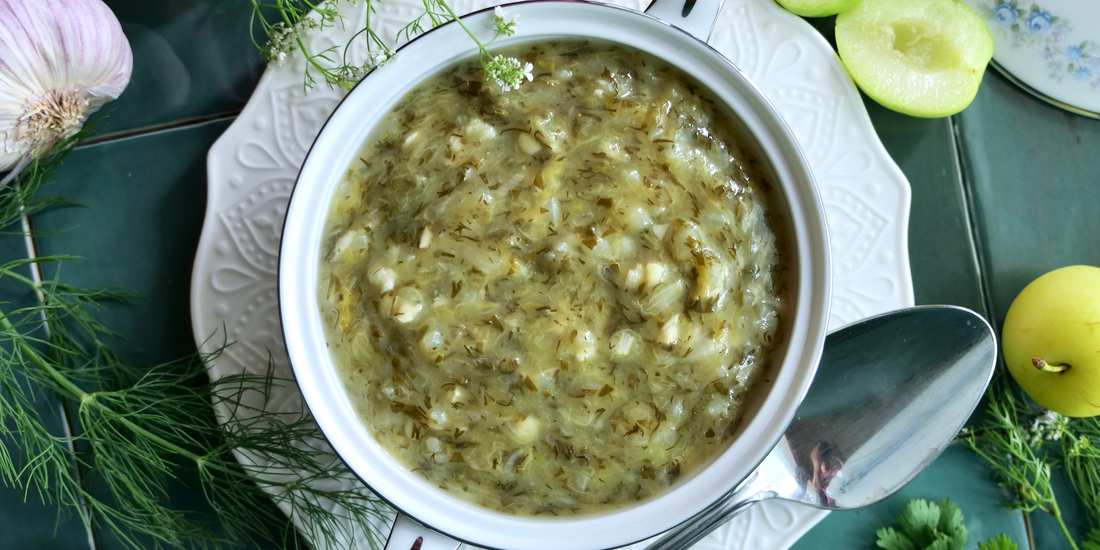
Georgian Plum Sauce (Tkemali)
Share
This recipe is part of my Caucasus x Appalachia series where I compare the facts and cultural impacts of plants that grow both here in America and in the Republic of Georgia. Wander over to the field journal to learn more about plums.

Tkemali is a saucy condiment that defines Georgian cuisine. It is made from plums, herbs, and onion/garlic. It can range in color and sweetness depending on which plums are used and when they are harvested. Perhaps the most classic version of tkemali is the tangy green one that uses sour, unripe plums harvested early in the season. This tkemali is piquant, salty, and more sour than sweet. It’s the type I encountered the most during my travels throughout Georgia.
Tkemali is like the Georgian version of ketchup. It’s often used as an accompaniment to fried potatoes, grilled meats, and other dishes commonly made in Georgian kitchens. Plums grow wildly in Georgia, and they are also cultivated. Georgian cuisine harnesses the tang and acidity of that local flora in the same but distinct ways other cultures do. One person’s plum is another’s lemon. Or another person’s tomato.

North America has wild and cultivated plums as well, although most Americans encounter only a select few commercial varieties at their local grocery stores. These are intended to be sweet. Intended is the key word here. Like turning lemons into lemonade, you can now take those mouth-puckering bummer plums you thought were ripe and turn plums into ketchup! Um, well, you know what I mean.
The recipe below is by no means the end-all-be-all tkemali recipe. It’s just an amalgamation and tweaking of the versions shared with me by Georgian friends. Some people spice it up with jalapenos or other chiles. Some might double the amount of fresh herbs or omit an herb altogether. At the end of the day, this is a condiment that’s made variously on a daily basis in Georgia. So keep it simple, easy, and use what’s accessible to you.

Georgian Plum Sauce (Tkemali)
INGREDIENTS
- 750g tart plums*
- 1 small yellow onion, finely diced
- 7 garlic cloves, minced
- 15g fresh dill, finely chopped
- 18g fresh coriander (cilantro), finely chopped
- ½ tsp pennyroyal (or other strong mint herb*), finely chopped
- ⅛ tsp sea salt
- Optional: 1 tablespoon sugar
INSTRUCTIONS
- Add plums to a large pot and cover with cool water.
- Simmer the plums on low-med heat for 15 minutes or until the plums start to soften and break down. Remove plums from the water with a slotted spoon and set aside. Reserve the water in the pot.
- Add a couple splashes of cooking oil to a large saute pan and set over medium heat. Once hot, add the onion and cook for 5 minutes or until soft and translucent. Then add the garlic and cook for another minute. Remove pan from heat.
- Take the cooked plums and remove as much skin as possible. Then run the plums through a sieve set over the pan of onions and garlic. Remove the pits, stems, and any remaining skin. Any pulp left in the sieve can be added to the pan.
- To the pan add dill, coriander, pennyroyal, salt, and opt: sugar. Stir the mixture well and cook over low-medium heat, simmering for 3-4 minutes while stirring. Use the reserved pot water to adjust the consistency of the sauce. It should be thick but still runny.
- Allow the tkemali sauce to cool and either serve immediately or keep it in the refrigerator until needed. Tkemali is best served at room temperature.
- Determine your desired levels of tart and sweet based on harvest time and plum variety more so than skin color. Some plums, like the Georgian alucha plum or the greengage types, stay green even when ripe.
- Other strong mint herbs similar to pennyroyal include: spearmint, lesser calamint, ground ivy, and mountain mint.
Fried Halloumi + Svaneti Salt + Tkemali
After making tkemali at home, I needed something to be the vessel for all that pungent plum goodness. What I created ended up being a nesting doll of cuisines, fusion if you will. I was first inspired by Georgian cheeses. It’s a little known fact, but Georgians are legendary cheese makers. They make very delicious and distinctive cheeses. You simply cannot interchange a Georgian cheese with an American one. So, I went with the next best thing: halloumi. Fried halloumi. Which is Greek, but might as well be British too since London is awash with these trendy sticks of fried cheese. And we’re not talking mozzarella sticks. That’s fried Italian cheese whose origins are hotly debated. Is your head spinning yet with my ramblings on culinary origins? Because mine is!
 Bringing the dish back to Georgian roots, I seasoned the fried halloumi with Svaneti salt. Svaneti salt is a unique and aromatic blend of Georgian spices, named for the mountainous Svaneti region of Georgia where this seasoning developed. The blend usually consists of coriander seeds, chili, blue fenugreek, garlic, yellow flower (marigold), and gitsruli (wild caraway seed from the Svaneti region). If all this seems overkill, then just go to Sonic and grab some mozz sticks for dipping into your freshly prepared tkemali. You might be the first person to ever do that. And that’s pretty darn cool.
Bringing the dish back to Georgian roots, I seasoned the fried halloumi with Svaneti salt. Svaneti salt is a unique and aromatic blend of Georgian spices, named for the mountainous Svaneti region of Georgia where this seasoning developed. The blend usually consists of coriander seeds, chili, blue fenugreek, garlic, yellow flower (marigold), and gitsruli (wild caraway seed from the Svaneti region). If all this seems overkill, then just go to Sonic and grab some mozz sticks for dipping into your freshly prepared tkemali. You might be the first person to ever do that. And that’s pretty darn cool.

